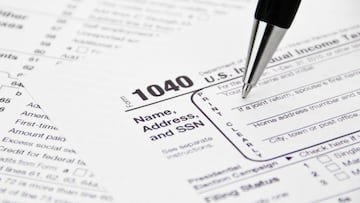IRS Tax Filing 2021 new date: what's the deadline?
The IRS has pushed back the 2020 tax filing deadline but even so, advises taxpayers not to delay and warns that state tax filings remain the same.

The Internal Revenue Service (IRS) has confirmed that it has extended the deadline for individual taxpayers to file their 2020 tax return as a result of the ongoing coronavirus pandemic. They will now have until 17 May, rather than 15 April, to submit their federal return.
The extension will not change the 15 June deadline to file with the IRS for the victims of the February winter storms in Texas, Oklahoma and Louisiana. But neither does the new federal deadline of 17 May apply to state deadlines, which vary from state to state, the IRS recommends checking with your state tax agency to make sure you file on time.
Tax filers should still file as soon as possible to receive missing stimulus payments
IRS Commissioner Chuck Rettig said in the statement "Even with the new deadline, we urge taxpayers to consider filing as soon as possible, especially those who are owed refunds.” He added “Filing electronically with direct deposit is the quickest way to get refunds, and it can help some taxpayers more quickly receive any remaining stimulus payments they may be entitled to."
Most taxpayers that file electronically can expect their tax return to be sent within 21 days. Free File allows you to prepare and file your federal income tax return for free.
Estimated tax payments are still due 15 April
Most taxpayers have their income withheld from their paychecks and is then handed over to the IRS by their employer. However, those who have income from self-employment, rental income, alimony or interest and dividends from investments still need to meet the 15 April deadline to pay any taxes due. These estimated tax payments are generally made quarterly to the IRS.
However, the extension does apply to those individual taxpayers who underpaid the IRS from their withholdings on their final tax bill. This will include individuals who pay self-employment tax. They will now have until 17 May to settle up with Uncle Sam without penalties and interest, regardless of the amount owed.
If you still can’t file by 17 May, file for an extension
If you can’t file by the due date of your return, you should request an extension of the deadline. To receive an automatic extension until 15 October, you must file Form 4868, "Application for Automatic Extension of Time To File U.S. Individual Income Tax Return" by the due date of your return, now by 17 May.
Individual tax filers, regardless of income, can use Free File to electronically request an automatic tax-filing extension. Filing this form gives you until 15 October to file a return. To get the extension, you must estimate your tax liability on this form and should also pay any amount still due at the time.
Pay taxes at the same time as requesting deadline extension for filing
You can also get an extension by paying all or part of your estimated income tax due and indicate that the payment is for an extension using Direct Pay, the Electronic Federal Tax Payment System (EFTPS), or a credit or debit card. This way you won’t have to file a separate extension form and you will receive a confirmation number for your records.
“If you do owe taxes, but you don’t have the money to pay it, file anyway.”@taxgirl shares 3 tax-filing tips for those struggling with finances amid the pandemic
— Bloomberg Quicktake (@Quicktake) March 4, 2021
Full segment: https://t.co/vs7f01bzbp #YourMoneyStory pic.twitter.com/VojSbWix0T
Even with extension, you still have to pay by the 17 May extended deadline
Extremely importantly, IRS clearly states that the extension of time on tax filing does not grant you an extension of time to pay your taxes. To the contrary, even if requesting an extension to file, you must estimate and pay your tax bill regardless by the new deadline, 17 May to avoid any possible penalties.
Remember, this does not apply to those who receive income that is falls under estimated tax payments, typically paid quarterly, on self-employment income and non-work-related income. That date is still 15 April.
What is "IRS Free File?"
The IRS Free File Program provides two ways for taxpayers to prepare and file their federal income tax online for free:
Income under $72,000 per year: the traditional IRS Free File system provides free online tax preparation and filing options on IRS partner sites. IRS partners are online tax preparation companies that develop and deliver this service at no cost to qualifying taxpayers. Please note, only taxpayers whose Adjusted Gross Income (or AGI) is $72,000 or less qualify for any IRS Free File partner offers. Simply use the Free File Offer Look Up Tool and enter basic information, then you select the offer you would like, and file your taxes through the company for free.
Income over $72,000 per year: Free File Fillable Forms are electronic federal tax forms you can fill out and file online for free. If you choose this option, you should know how to prepare your own tax return. Please note, it is the only IRS Free File option available for taxpayers whose AGI is greater than $72,000.
Required documentation to file your tax return
These are the documents you will be required to complete if you'll be using the above tools to fill out your 2020 tax return:
Personal information
- A copy of last year's tax return in order to access your Adjusted Gross Income (AGI)
- Valid Social Security numbers for yourself, your spouse, and any dependent, if applicable
Proving your AGI: income and receipts
- Social Security benefits documentation
- Unemployment Compensation documentation
- All receipts pertaining to your small business, if applicable
- Income receipts from rental, real estate, royalties, partnerships, S corporation, trusts
Other income
- W-2s, showing your annual wages from all of your employers
- Form 1099-INT, showing interest paid to you throughout the year
- Form 1099-G, showing any refund, credit or offset of state and local taxes
- Forms 1099-DIV and 1099-R, showing dividends and distributions from retirement and other plans paid to you during the year
Affordable Care Act (ACA) filers
- Form 1095-A, Health Insurance Marketplace Statement. For more information see Affordable Care Act (ACA) Tax Provisions.
- Form 8962, Premium Tax Credit
File electronically
- Verify your identity by using your 2019 AGI. If you created a 2019 personal identification number, that will work too. The personal identification number requires that you create a five-digit PIN that could be any five numbers (except all zeros) that you choose which serves as your electronic signature.
- Can't find your AGI or PIN? If you do not have a copy of your 2019 tax return, you may use the IRS Get Transcript self-help tools to get a tax return transcript showing your AGI. You have two options:
- Online: Select the Tax Return Transcript and use only the “Adjusted Gross Income” line entry. Secure Access: How to Register for Certain Online Self-Help Tools provides you with the information you need to make the request.
- By Mail: Please allow 5 to 10 days for delivery. Use only the “Adjusted Gross Income” line entry.
The IRS warns of delays and a challenging 2021 tax season, here are 10 tax tips for filing your 2020 tax return https://t.co/yR9pExF2p6 pic.twitter.com/EPUum6PKsT
— Forbes (@Forbes) February 12, 2021
Valid email address required for contact
To get a notification from the Free File software company that your return was accepted by IRS, you need a valid email address, ensure to have this ready when starting.
Recovery Rebate Credit
If you didn't receive your stimulus check - or Economic Impact Payment - or only got part of the full amount, you may be eligible to claim the rest through a Recovery Rebate Credit
How long will it take to process my tax refund?
Related stories
You will usually receive your refund within three weeks of the date when the IRS receives your return, even faster if you choose to have it directly deposited into your checking or savings account.
Though there’s a notice on the IRS advice website that states that they’re having some staffing issues, so processing paper tax returns could take several weeks longer. Taxpayers and tax professionals are encouraged to file electronically.
If you have a quick tax question, check our quick answers – take a look at the #IRS FAQs: https://t.co/gHnxHcZMtW pic.twitter.com/lWF5HEnLdQ
— IRSnews (@IRSnews) March 16, 2021

